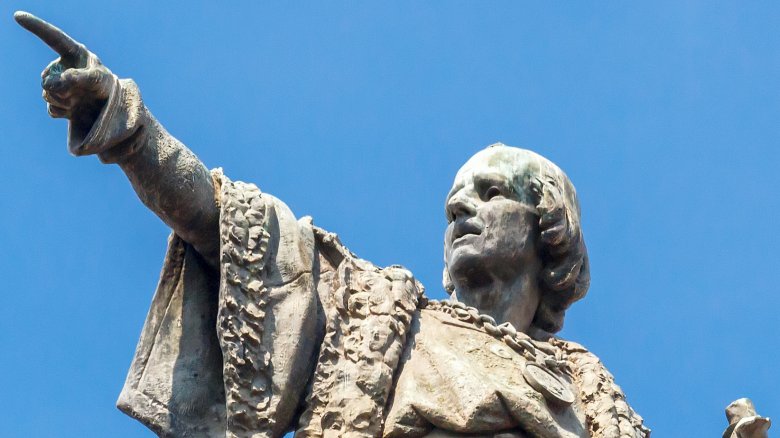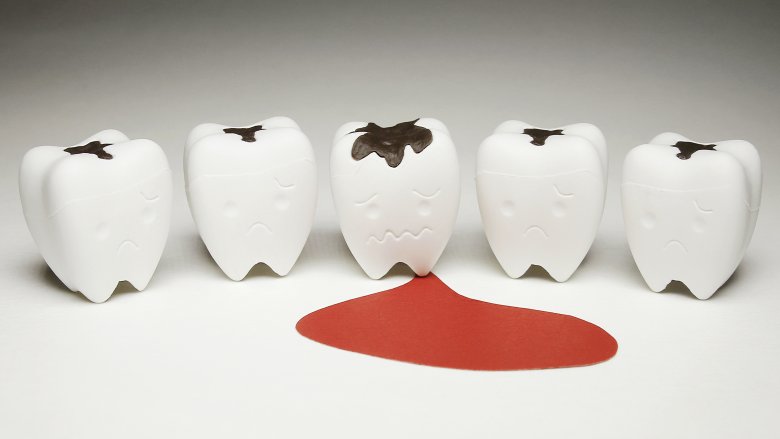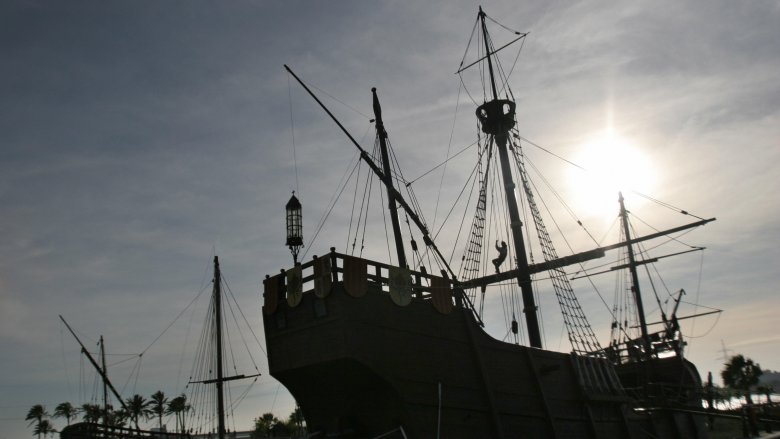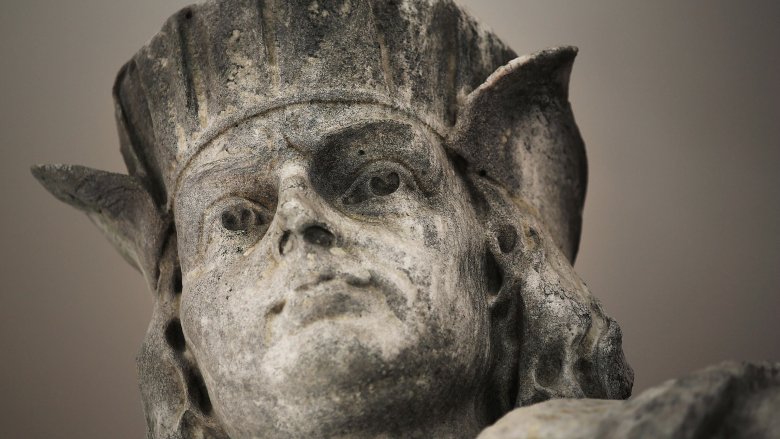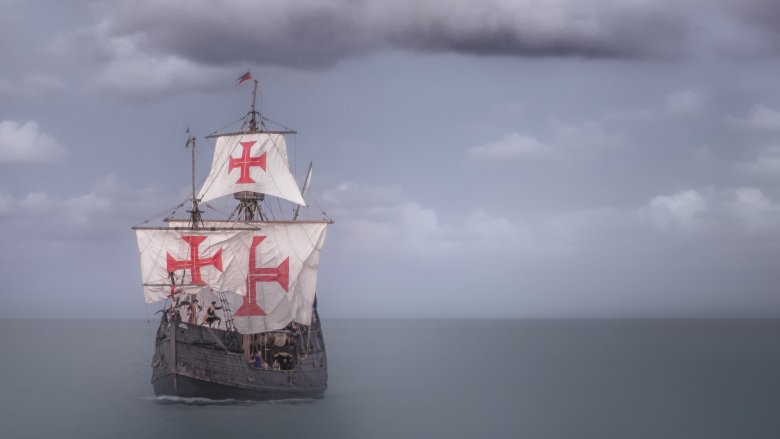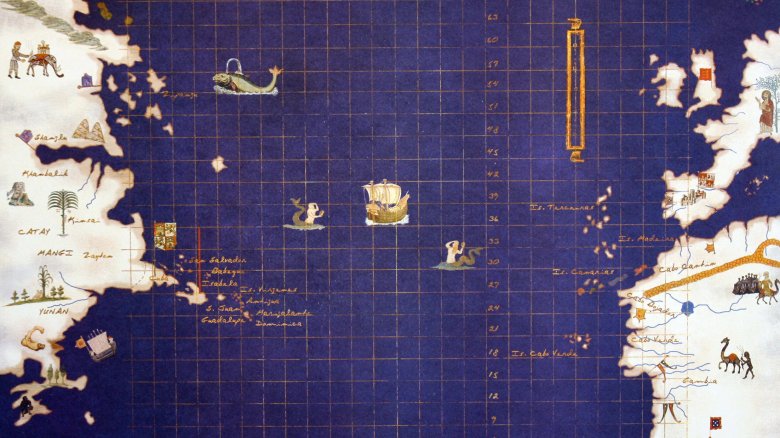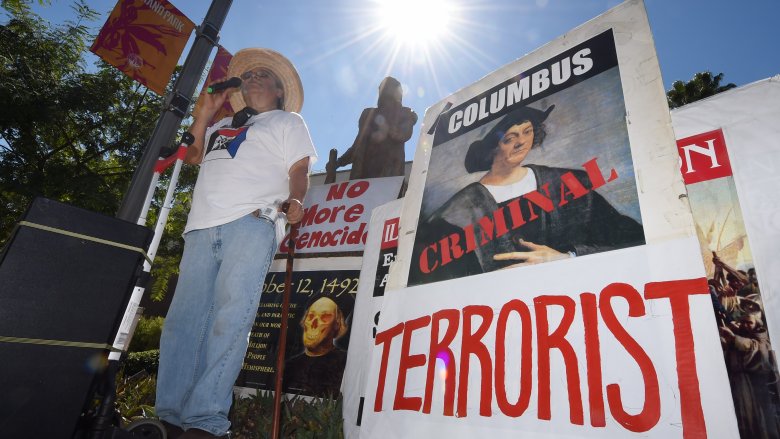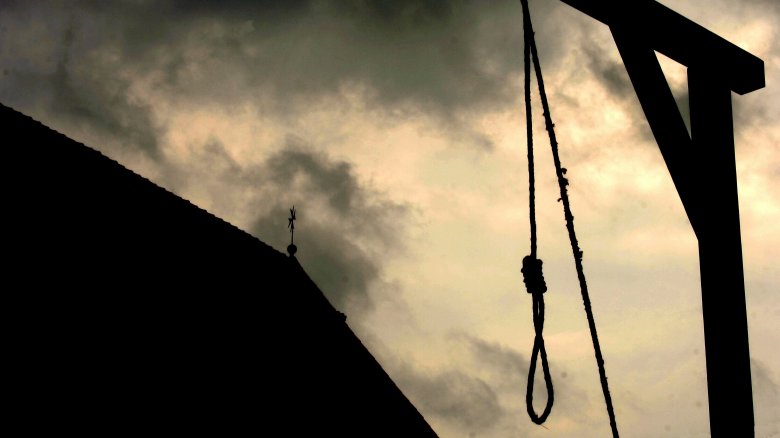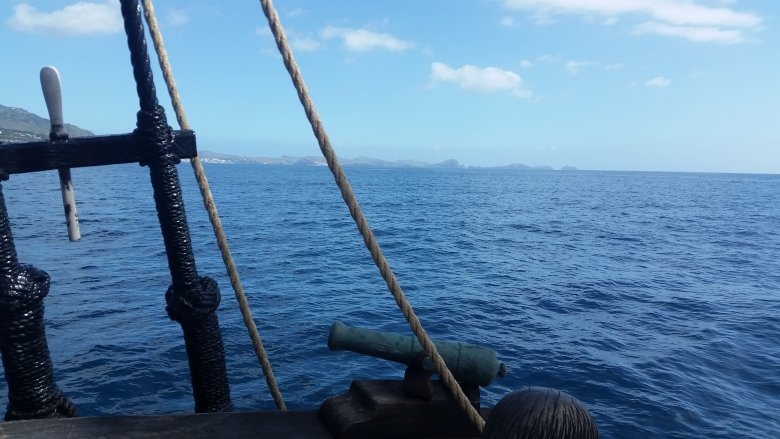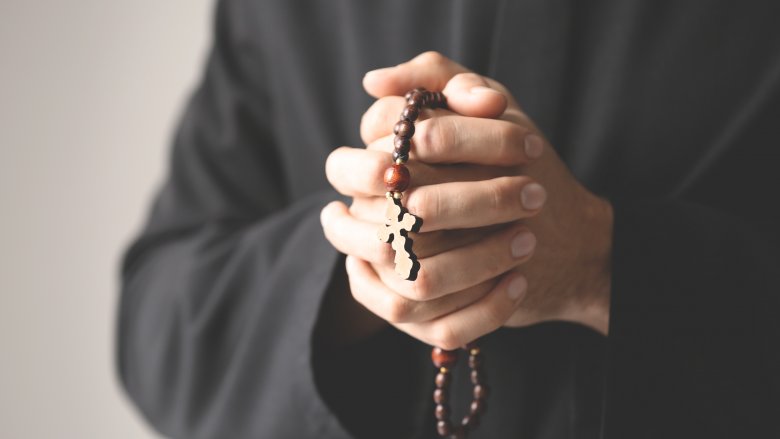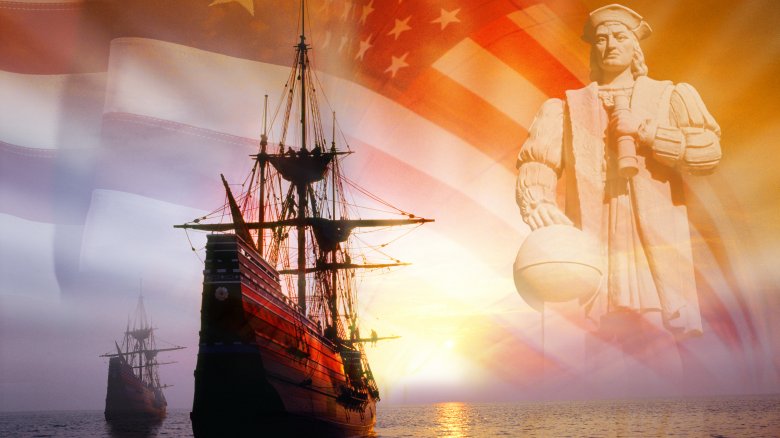Why You'd Never Survive Life Exploring The New World With Christopher Columbus
There are a lot of polarizing figures in history; that's just how people work. Few are as polarizing as Christopher Columbus, though, who's long enjoyed enough popularity to have his own national holiday, plenty of statues, and a rather heroic role played out in history classes across the nation.
His story is a strange one, because somewhere along the line, it moved out of history and into the stuff of legend: An intrepid explorer, not giving up on his dream, finally convincing someone to give him a chance, and discovering America. There are so, so many problems with that — starting with the fact, says National Geographic, that he definitely didn't discover America.
What he did do, however, was a whole bunch of nasty things that led to opening up an entire continent to a whole bunch more nasty things. And everyone knew it at the time, too — his career ended with his arrest and complete fall from grace with the only monarchs that had supported him. For some reason, he still became the stuff of American legend and it still seems like it would have been pretty cool to head out with him, sailing the seas, discovering new worlds, meeting new people... then killing them. Right, so maybe not that last part. At any rate, there's more bad news: you absolutely wouldn't have survived to tell the tale, and here's why.
Yes, Virginia, it's possible your body can disintegrate
Ah, scurvy — the disease National Geographic estimates killed around two million seafaring sailors and adventurers between the 15th and 18th centuries. Herman Melville simply called it the "sickness" when he was writing Moby Dick. So, what happens? When the body doesn't get enough vitamin C — which happens a lot during long periods at sea — it starts to stink. Then, it starts to break down. Without getting too graphic, blood blisters form on the skin, turn into ulcers, and break open. Old wounds reform, old broken bones weaken and break again, cartilage disappears, blood starts to leak everywhere, and the body stops producing collagen, which it needs if you want to hold the whole thing together. Oh — and the brain starts breaking down, too.
What does this have to do with Columbus? Archaeologists from the Universidad Autonoma de Yucatan were excavating the graveyards of Columbus's La Isabela settlement when they noticed something about the bones. There were signs that the men had been suffering from scurvy, a surprising thing considering the Caribbean is literally ripe with foods full of vitamin C. But when they got there, they stockaded themselves behind settlement walls and appealed to Spain for more food instead of just checking what was around them. "...Columbus himself was more concerned with looking for gold that feeding his people," one of the study authors wrote, and in his determination, he condemned them to a terrible fate.
Columbus caused 39 deaths right off the bat
Everyone's familiar with the story of the voyage of the Nina, the Pinta, and the Santa Maria. But of the crew of the three ships, 39 of the sailors didn't last the year.
On Christmas Day, 1492, the Santa Maria ran aground near a Caribbean island. The ship's wood was used to build a fort called Villa de la Navidad, and after three weeks, Columbus headed out — leaving behind 39 sailors and telling them to literally hold down the fort. And find some gold. He was gone a year, and the Smithsonian reports, when he returned with 17 ships and 1,200 men, they found nothing but ashes where La Navidad had once stood. Archaeologists are still trying to piece together the story of what happened, starting with the exact location of the fort (although likely sites have been discovered). According to the University of Florida, Columbus and his men built their town near a village belonging to the local Taino. They opened their doors to the shipwrecked men, and when Columbus returned, they told him that his men had died — some had been fighting each other, and the rest had been killed in a fight with a rival tribe. Columbus moved on.
Local lore tells a different story, though. Not satisfied with the meager amount of gold the Taino had to offer, the Europeans started taking slaves and mistresses. To make it stop, the Taino killed the men and burned the town.
You probably had syphilis
When it comes to any major disease, people love to do some serious finger-pointing about where it came from. Historians have even spent a long time tracking down the source of the plague, and when it comes to syphilis, this particular STD and Columbus's crew are old friends. Researchers from Mississippi State University (via LiveScience) call syphilis "one of the first global diseases," and say that knowing where it originated and how it spread across the globe might help us understand the spread of other diseases. And where did it come from? Columbus's crew.
There's a few pieces of almost indisputable evidence: the first real cases of syphilis didn't happen in Europe until Columbus returned from the New World, and when researchers started tracing the bacteria responsible for syphilis, they traced it all the way back to the New World. There, they found another, related disease called yaws, which loves hot, humid areas and is transmitted by skin-to-skin contact. The belief is that when Columbus's crew brought it to Europe, it mutated to thrive in other hot, humid areas... on the human body, and that's when it became an STD.
Not everyone agrees that's what happened, and Quartz says there's an argument that it was explorers from Europe who took syphilis to the New World. Either way, at some point it was on the ships and in the sailors, and it was deadly.
Sanitation on Columbus' ships was so bad, anything could have killed you
When Columbus died in 1506, he was just 54-years-old. He was suffering from reactive arthritis, and while it's treatable now, it wasn't back in ye olde times. It caused the heart attack that killed him, and we know this thanks to researchers from the University of Granada (via Medical Daily). Researchers think he likely developed the disease after being exposed to food poisoning on one of his voyages. But that's not the only thing that could have caused it, and in Post Mortem: Solving History's Great Medical Mysteries, researchers look at what else could have happened... and there's a lot of possibilities that give a disturbing glimpse into just what it must have been like on board his ships.
Brucellosis is a possibility, an infection spread to people from goats. There's a small chance it was syphilis, but that seems unlikely given Columbus's symptoms. It's also possible that Columbus was exposed to a bacteria carried by birds like the parrots he took back to Spain; the infection would have been spread through the air, and it's possible the birds he kept in his own quarters ultimately led to his early death.
Regardless of how it happened, Columbus definitely wasn't the only one exposed to all of those things. The ships were known for non-existent sanitation, plenty of food poisoning, and deadly conditions — definitely not as glamorous as the songs make it out to be.
Columbus' first settlement was definitely cursed
Columbus's first real settlement was La Isabela, located on the north side of the island now called Hispaniola. It was home to a farms, a fortified town center, Columbus's personal house, and a whole lot of bad karma.
Built on Columbus's second journey, things started out bad. There was little food and little water, and when Columbus ordered people to start planting crops and building a wall to protect their huts, no one was happy about staying there. Charles C. Mann, author of 1493, says (via Salon) it wasn't long before Columbus abandoned his settlement to continue his search for Asia, while ordering them to keep looking for gold. When they couldn't even find that, the hungry residents ended up raiding the storehouses of the local Taino, and it's not even necessary to describe how poorly that went. Taino groups banded together to drive out the Europeans, and it was a case of steel weapons against chemical warfare featuring gourds filled with ash and ground hot peppers. The Taino were so desperate to get rid of the intruders that they destroyed their own food supplies, crops, and homes, hoping to give them nothing to take away.
La Isabela continued under a cloud of starvation and bloody conflict. Columbus headed back to Spain in defeat and with a desperate appeal for more money, supplies and men, while the cemeteries continued to fill. It was all abandoned in a matter of years.
Entire groups hated Columbus from the start
When Columbus and his men "discovered" the New World, there were already people living there. Conventional history has long said there were two groups, the Arawaks and the Caribs. The Arawaks were kind and welcoming, while the Caribs were demonized as cannibals. Scientific American says the labels are troubling, and suggests that Columbus used the idea of the evil Caribs to justify enslaving them.
According to the Smithsonian, while the Caribs' evil nature was exploited and exaggerated by a Columbus determined to get what he wanted, they were very, very hostile to the Europeans that arrived on their shores. They were described as meeting them not with open arms but with showers of poisoned arrows, but it's likely that's just part of the story.
William Keegan of the Florida Museum of Natural History suggests Columbus and his crew observed aggression and old wounds that came from a bartering system they just didn't understand. Columbus made numerous records of exchanges on various islands where he stopped to trade goods with the native peoples, and while trades could go well, an insulting trade could go very, very badly and end in bloodshed, if someone had been severely insulted. "The point is that the potential for hostilities was always present," Keegan says. "Columbus's observations suggest that hostilities were a component of indigenous exchange relations in the Bahamas." And a looming sort of impending doom is nothing short of terrifying.
There was a chance Columbus would execute you himself
Columbus was a horrible governor, and according to the eyewitness reports of those who were sent to try to help his struggling colonies, his men had a very good chance of meeting their end thanks to Columbus himself.
When the Chief Justice of Hispaniola, Francisco Roldan, reported back to the Archbishop of Toledo in 1499, he painted a dire picture of life at the settlement. When Columbus left in 1498, he put his brother in charge. Roldan wrote, "... he began to act with such severity that he caused people to fear and hate him..." With starvation looming, Roldan took some of the other settlers and attempted to reach another village in hopes of finding supplies. They were attacked, retreated, and once Columbus's brother heard of it, his response was less than understanding: "I will go there and cut off his head and those of more than eight others."
According to American Heritage, Columbus had appealed to Spain for more men. The same monarchs that had once supported him were dubious about sending more men, but they did send Francisco Bobadilla. An officer of the crown, he was tasked with getting Columbus back to Spain. When Bobadilla got to Hispaniola, the first thing he saw were the gibbeted remains of six Spanish settlers. Diego Columbus confirmed there were more executions scheduled, and in the end, Bobadilla jailed the three brothers and sent Columbus back to Spain — in chains.
You were riddled with diseases
When Columbus went to the New World, there were more than just men and weapons on board his ships. According to the Oklahoma Medical Research Foundation, Columbus — and others who came from the densely populated cities of Europe — brought devastating illnesses with them. When ships first landed in 1492, estimates suggest there were around 250,000 indigenous people living in Hispaniola. Within 30 years, that number dropped to around 14,000. One major factor was the introduction of infectious diseases like smallpox, influenza, and measles, which were devastating to an entire population of people who had no previous exposure and no natural immunities to the diseases.
According to research published in the Journal of Economic Perspectives, the so-called Columbian Exchange was as much about disease as it was about anything else. Europeans brought typhus, chickenpox, cholera, plague, diphtheria, whooping cough, and scarlet fever, too, and here's the thing — a lot of those diseases were deadly even to the Europeans who carried them. The Mayo Clinic says cholera is almost always fatal if left untreated, measles is still incredibly deadly, especially to children, and diphtheria and the plague are pretty deadly, too.
And that means it wasn't just people in the New World who died from these horrible diseases, it would have killed the people who carried them there, too.
No one wanted your religion
According to Religion and American Cultures, the very first time Catholic priests set foot in the New World was as a part of Christopher Columbus's return journey in 1493. By 1501, Columbus wrote the Book of Prophecies, and one of the things he clearly pointed out was that he had laid the groundwork for converting Spain's new territories to Catholicism.
How'd that work out for those Columbus took? For some, not so bad. ThoughtCo. says the priest Ramon Pane spent four years living with the Taino, and wrote some of the most important works we have on their history and culture. But according to American Heritage, just because someone was a priest, that didn't get them special treatment from Columbus. One was among the number of a group of sick, angry settlers who returned to Spain with him in 1496; the outraged Columbus had denied the priest food after he'd spoken up on behalf of some settlers Columbus put to the whip.
And what about the ones that followed in his footsteps? Not great. Spain decided to use religion as a way of controlling their new territories, and when they sent missionaries over to spread the word, those people were — to quote the National Park Service — "at great peril among mostly hostile natives." Forts were built alongside missions, and it was only with the ever-present threat of Spanish arms that the missionaries had even the slightest chance of surviving.
You'd have to be ok with doing some horrible things
It's nice to think that at heart, deep down, people are a decent sort. The sort that would have a problem with hunting down those who hadn't been able to find enough gold in the rivers, the sort that would definitely not want to train dogs to kill then use them as weapons. If you like to think you're the sort of person that wouldn't do something like that, then congratulations, you wouldn't have survived exploring with Columbus. Good for you.
According to the Smithsonian, it was the Arawaks — the people who Columbus described as "so full of love and without greed... and they are always smiling" — who found themselves very, very quickly at the mercy of cruel European settlers and their tribute system, which demanded gold, gold, and more gold. But not even Columbus's system of tributes was enough for many of his men, who insisted that they get land and people as well as gold. Bartolome de Las Casas wrote that countless indigenous people were tortured and fed to the dogs, and that those who survived, didn't live. They stopped having children, not wanting to bring other lives into the world that had become a waking nightmare. They committed suicide, too, even as Columbus' priest claimed they rejoiced at their welcome into Christ's flock.
Don't think you could be a part of that? Good.
